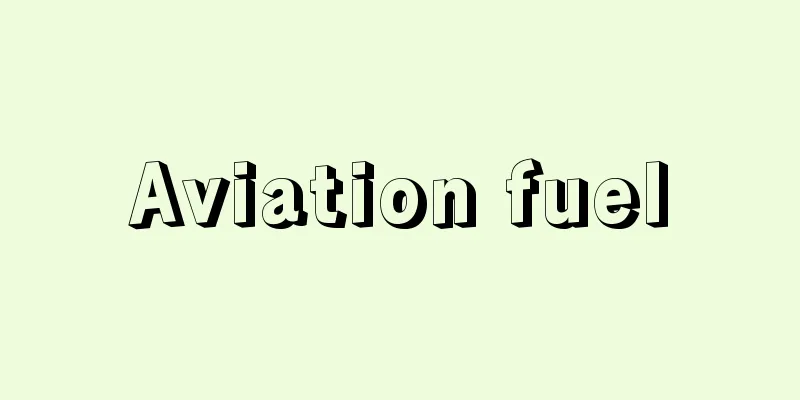Aviation fuel

|
A general term for fuel used in aircraft engines. In the past, steam engines, electric motors, and even diesel piston engines were used as engines for aircraft, but today most are piston engines that use gasoline as fuel, and turbine engines that use kerosene (light oil)-based fuel, with rocket engines being used as special applications. Therefore, aviation fuel can be said to consist of aviation gasoline and jet (turbine) fuel. [Kazuo Ochiai] Aviation fuel propertiesThe operating conditions of aircraft engines vary greatly from those of ground engines, and because they require a large output relative to their size, aviation fuel also needs to have characteristics that can adapt to these conditions. (1) Large heat generation. For example, in a jet engine, fuel is continuously burned in the combustion chamber. Since thrust is proportional to the heat generation of the fuel, a high heat generation directly translates into increased thrust and reduced fuel consumption. The calorific value of aviation fuel is measured in BTUs (British thermal units) per pound (453.6 grams) or kilocalories per kilogram; aviation gasoline must have a minimum of 18,720 BTU/pound, while jet fuel must have a minimum of 18,400 BTU/pound. (2) Good combustibility. It must be easy to start and burn continuously, and must burn completely so as not to produce soot or toxic gases. (3) Good volatility and little tendency for vapor lock at high altitudes. As the altitude increases, the air pressure drops and the temperature drops, reaching -56.5°C under standard conditions in the stratosphere. In polar regions, temperatures can drop below -50°C on the ground. Low volatility makes the fuel difficult to ignite, and starting and burning properties at low temperatures are poor. Conversely, if there is a large amount of low-boiling-point components mixed in, vapor that vaporizes in the fuel pipes can clog the pipes, easily causing vapor lock, which causes uneven fuel supply. (4) It must be able to withstand low temperatures and have a low water content. If the fuel has poor low-temperature resistance, the low temperatures at high altitudes will cause the fuel to become more viscous, leading to uneven fuel supply and poor combustion in the combustion chamber. In addition, the fuel's composition may change, and dissolved water may solidify and clog the fuel filter or piping. (5) High chemical and thermal stability. The environment of an aircraft is subject to large temperature changes, and stability is also necessary during storage and transportation. (6) Non-corrosive. The sulfur contained in the fuel corrodes fuel tanks, piping, and engine parts. In addition, the bacteria contained in jet fuel can grow and clog filters and piping, and can erode the seals that prevent fuel tanks from leaking. (7) Aviation gasoline has necessary and sufficient antiknock properties. (8) Easy availability and low price. Aircraft consume large amounts of fuel, so it is necessary to refuel at various locations. The importance of the price of aviation fuel is shown by the fact that the air transportation industry, which was at the height of its prosperity in the 1960s, was hit by a major recession in the 1970s due to the first and second oil panics. [Kazuo Ochiai] Aviation gasoline and jet fuelAs mentioned above, it is the most common aviation fuel. (1) Aviation gasoline Crude oil is separated into light volatile oil, heavy volatile oil, kerosene, diesel, and heavy oil depending on the temperature of distillation. Gasoline is obtained by refining the light volatile oil fraction to meet specifications. Aviation gasoline is required to have sufficient anti-knock properties, moderate volatility, high heat generation, high chemical stability, and cold resistance. Anti-knock properties are particularly essential, and gasoline is divided into several grades indicated by octane number or performance (output) number depending on the characteristics of the engine used. Currently, 100/130 or 91/96 octane gasoline is widely used, but due to improved engine reliability and rising fuel prices, the use of high-octane gasoline for automobiles is also being considered in some areas. (2) Jet fuel: A mixture of fractions ranging from light volatile oil to kerosene according to specifications. There are two types: wide cut gasoline and kerosene-based fuel. Wide cut gasoline is called Jet B or JP-4, and is made by adding kerosene to a mixture of light volatile oil and heavy volatile oil (naphtha). Kerosene-based fuel is called Jet A or JP-5, and is refined from kerosene fractions, but for safety reasons, kerosene-based fuel with a high flash point is used in civil aviation. Aircraft carry large amounts of fuel, and an accident would cause great damage, so research is being conducted to ensure safety, such as preventing fires in the event of a crash and fuel leakage. [Kazuo Ochiai] [References] | |Source: Shogakukan Encyclopedia Nipponica About Encyclopedia Nipponica Information | Legend |
|
航空機の原動機(エンジン)に使用される燃料の総称。航空機用の原動機には、古くは蒸気エンジン、電気モーターのほか、ピストンエンジンでもディーゼルエンジンが用いられたこともあったが、現在ではそのほとんどがガソリンを燃料とするピストンエンジンと、ケロシン(軽油)系の燃料を使用するタービンエンジンで、特殊な用途としてロケットエンジンが使われる程度である。したがって、航空燃料は航空ガソリンとジェット(タービン)燃料とからなるといってよい。 [落合一夫] 航空燃料の特性航空原動機の運転条件は地上のエンジンと異なり大きく変化すること、また大きさの割に大きな出力が要求されるので、航空燃料もそれに適応する特性が必要である。 (1)発熱量が大きいこと。たとえばジェットエンジンでは燃料は燃焼室で連続的に燃焼している。推力は燃料の発熱量に比例するので、高い発熱量は推力の増大と燃料消費量の減少に直結する。 航空燃料の発熱量は1ポンド(453.6グラム)当りのBTU(British thermal unit252カロリー)、または1キログラム当りのキロカロリーで示されるが、航空ガソリンでは1万8720BTU/ポンド以上、ジェット燃料では1万8400BTU/ポンド以上が要求されている。 (2)燃焼性がよいこと。始動性と燃焼の持続性がよく、また煤煙(ばいえん)や有毒ガスを発生しないように完全燃焼することが要求される。 (3)揮発性がよく、高高度でのベーパーロックvapor lock(蒸気閉塞(へいそく))の傾向が少ないこと。高高度に上昇すると気圧とともに気温も低下し、成層圏では標準状態でも零下56.5℃に達する。また極地では地上でも零下50℃以下になることもある。揮発性が低いと引火しにくく、低温時の始動性と燃焼性が悪くなる。逆に沸点の低い成分の混入が多いと、燃料配管の中で気化した蒸気が配管をふさいで燃料の供給を不均一にするベーパーロックをおこしやすい。 (4)低温に耐え、水分の含有率が少ないこと。耐低温性が悪いと、高高度の低温により燃料の粘度が高くなって供給が不均一になったり、燃焼室での燃焼状態が悪くなる。また、燃料の成分が変化したり、溶解している水分が凝固して燃料フィルターや配管を詰まらせる危険もある。 (5)化学的・熱的に安定性が大きいこと。航空機は環境上、温度変化が大きく、また貯蔵や輸送に対しても安定性は必要である。 (6)腐食性がないこと。燃料に含まれている硫黄(いおう)分は燃料タンクや配管・エンジン部品を腐食させる。またジェット燃料では、燃料に含まれているバクテリアが繁殖してフィルターや配管を詰まらせたり、燃料タンクの漏れ止めのシール剤を侵食することがある。 (7)航空ガソリンでは、必要かつ十分なアンチノック性があること。 (8)入手しやすく価格が安いこと。航空機は大量に燃料を消費するため、各所で補給する必要がある。1960年代に隆盛の極にあった航空輸送業が、70年代に相次いで起こった第一次、第二次の石油パニックで一挙に大不況にみまわれたことは、航空燃料の価格の重要性を示している。 [落合一夫] 航空ガソリンとジェット燃料前記のようにもっとも一般的な航空燃料である。 (1)航空ガソリンaviation gasoline 原油を蒸留の温度によって、軽揮発油、重揮発油、灯油、軽油、重油に分離する。ガソリンは、軽揮発油留分を規格にあうように精製して得られる。航空ガソリンには、十分なアンチノック性、適度の揮発性、高発熱性、高化学安定性、耐寒性などが要求される。とくにアンチノック性は不可欠で、使用するエンジンの特性に応じてオクタン価またはパフォーマンス(出力)価で示される何段階かのグレードに分けられている。現在広く用いられているのは100/130または91/96オクタン程度だが、エンジンの信頼性の向上と燃料価格の高騰により、自動車用高オクタンガソリンの使用も一部で考慮されている。 (2)ジェット燃料jet fuel 軽揮発油から灯油までの留分を規格にあわせて配合する。ワイドカットガソリンwide cut gasolineとケロシンkerosene系燃料の2種類がある。ワイドカットガソリンはジェットBまたはJP‐4とよばれ、軽揮発油と重揮発油(ナフサ)の混合に灯油を加えてつくる。ケロシン系燃料はジェットAまたはJP‐5とよばれ、灯油留分から精製されるが、安全対策上、民間航空では引火点の高いケロシン系燃料が使用される。航空機では大量の燃料を搭載しているので、事故が起これば大きな被害をもたらすため、墜落して燃料が漏れた場合の火災の防止など、安全性の確保についての研究が進められている。 [落合一夫] [参照項目] | |出典 小学館 日本大百科全書(ニッポニカ)日本大百科全書(ニッポニカ)について 情報 | 凡例 |
<<: Aeronautical radio‐navigation aid
>>: Aviation logbook - kokuunisshi (English) log book
Recommend
OTC drugs
... Less than 10% of drugs are distributed throug...
Colombe, F. (English spelling) ColombeF
…French manuscript illustrator. Born into a famil...
Hosocho (thin butterfly) - Hosocho
A general term for insects belonging to the Nympha...
Hanyu-zaka
A slope where the ancient Tajihi Road crosses the ...
Long dress - Kisenaga
…For the history of the development of armor in a...
Staples
Designated markets in medieval England. They were ...
counter-city strategy
In this strategy, McNamara emphasized a nuclear r...
Asyut (English spelling)
The capital of Asyut Governorate in Middle Egypt. ...
Lanz point
…Generally, when there is inflammation in the int...
Gyokurinen - Gyokurinen
A collection of songs. The eighth anthology of sog...
Great Thou and Little Thou - O-nan-ji-ko-nan-ji
〘Noun〙 An oral tale passed down by hunters. Also, ...
Ugo Foscolo
A poet representing the Italian pre-Romantic peri...
nymphomania
…In the case of women, narcissists who unconsciou...
Exploration - Tansa (English spelling) exploration
It is more of a common noun than an engineering t...
dissected maps
...This game was first created in the 1760s by a ...









